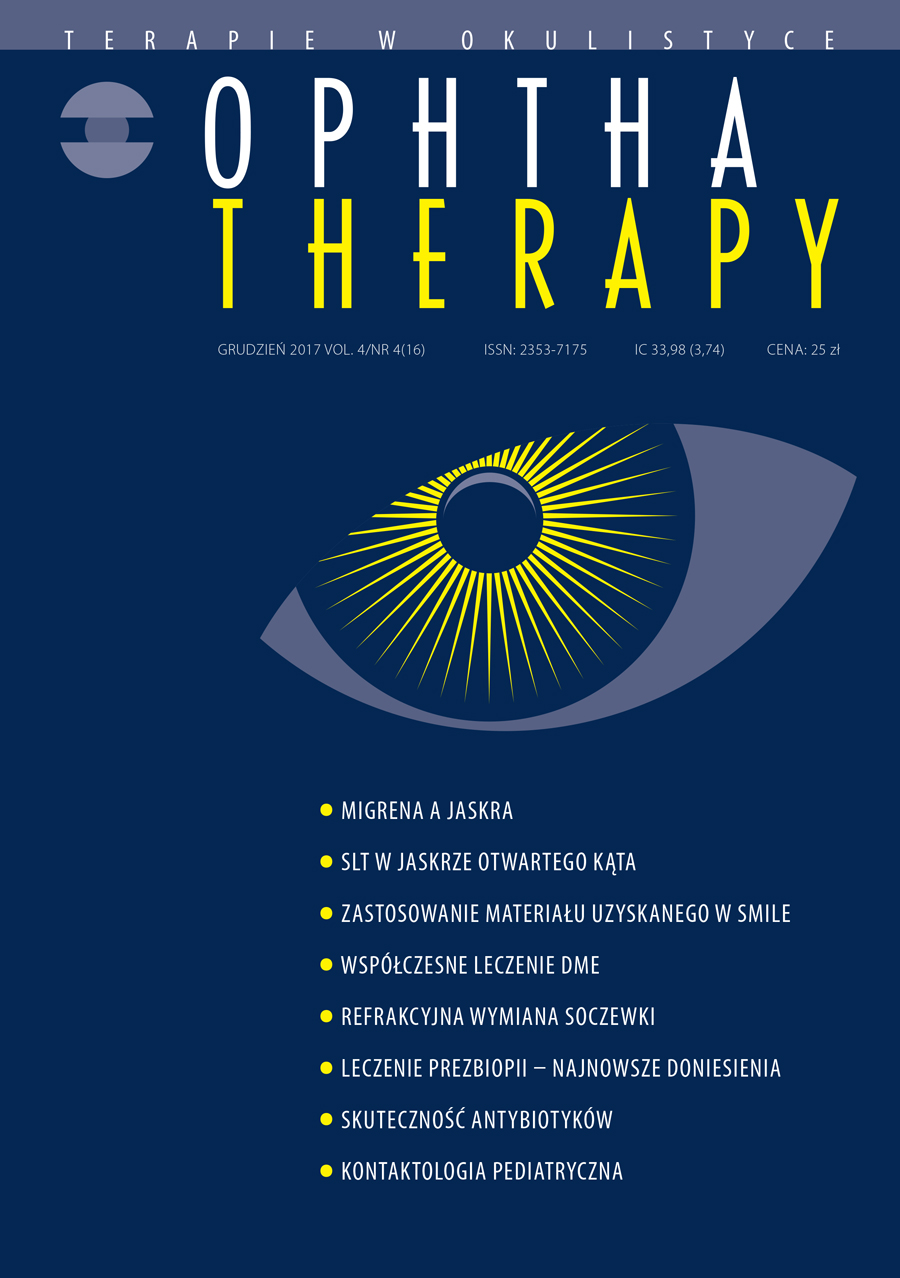Czy migrena jest czynnikiem ryzyka jaskry?
##plugins.themes.bootstrap3.article.main##
Abstrakt
Migrena to wieloczynnikowe schorzenie neurologiczne, w którego przebiegu występują ostre bóle głowy. Bóle migrenowe często zaburzają życie zawodowe oraz rodzinne, ponieważ znacznie obniżają jakość życia. Migrena jest jednym z najdroższych schorzeń neurologicznych, co wynika nie tylko z wysokich kosztów jej leczenia, ale także pośrednio ze spadku produktywności chorego w pracy. Badania epidemiologiczne wskazują na częstsze występowanie migreny u pacjentów z jaskrą, zwłaszcza z jaskrą normalnego ciśnienia. Dotychczas nie wykazano, aby migrena była czynnikiem ryzyka jaskry pierwotnej zamkniętego kąta. W diagnostyce różnicowej należy jednak mieć na uwadze, że jaskra pierwotna zamkniętego kąta może być przyczyną bólów głowy.
Pobrania
##plugins.themes.bootstrap3.article.details##

Utwór dostępny jest na licencji Creative Commons Uznanie autorstwa – Użycie niekomercyjne – Bez utworów zależnych 4.0 Międzynarodowe.
Copyright: © Medical Education sp. z o.o. License allowing third parties to copy and redistribute the material in any medium or format and to remix, transform, and build upon the material, provided the original work is properly cited and states its license.
Address reprint requests to: Medical Education, Marcin Kuźma (marcin.kuzma@mededu.pl)
Bibliografia
2. Tham Y, Li X, Wong T et al. Global prevalence of glaucoma and projections of glaucoma burden through 2040: a systematic review and meta-analysis. Ophthalmology. 2014; 121(11): 2081-90.
3. Mallick J, Lily D, Maliick Pradeep K. Update on Normal Tension Glaucoma. J Ophtalmic Vis Res. 2016; 11(2): 204-8.
4. Noseda R, Burstein R. Migraine pathophysiology: anatomy of the trigeminovascular pathway and associated neurological symptoms, CSD, sensitization and modulation of pain. Pain. 2013; 154(Suppl 1): S44-53.
5. Asghar M, Hansen A, Amin F. Evidence for a vascular factor in migraine. Ann Neurol. 2011; 69(4): 635-45.
6. Shields M. Normal-tension glaucoma: is it different from primary open-angle glaucoma? Curr Opin Ophthalmol. 2008; 19(2): 85-8.
7. Kim D, Seo J, Kim S, Hwang S-S. Comparison of localized retinal nerve fiber layer defects between a low-teen intraocular pressure group and a high- teen intraocular pressure group in normal-tension glaucoma patients. J Glaucoma. 2007; 16: 293-6.
8. Flammer J, Konieczka K. The primary vascular dysregulation syndrome: implications for eye diseases. EPMA J. 2013; 4(1): 14.
9. Gramer G, Bernard H, Gramer E. Migraine and Vasospasm in Glaucoma: Age-Related Evaluation of 2027 Patients With Glaucoma or Ocular Hypertension. Investigative Ophthalmology & Visual Science. 2015; 56: 7999-8007.
10. Hewitt W, Wu J, Green C et al. Systemic disease associations of familial and sporadic glaucoma: the the Glaucoma Inheritance Study in Tasmania. Acta Opht. 2010; 88(1): 70-4.
11. Wang J, Mitchell P, Smith W. Is there an association between migraine headache and open-angle glaucoma? Findings from the Blue Mountains Eye Study. Ophthalmology. 1997; 104(10): 1714-9.
12. Phelps C, Corbett J. Migraine and low-tension glaucoma. A case-control study. Invest Ophthalmol Vis Sci. 1985; 26(8): 1105-8.
13. Chen H, Lin C, Kao C. Does Migraine Increase the Risk of Glaucoma?: A Population-Based Cohort Study. Medicine (Baltimore). 2016; 95(19): e3670.

